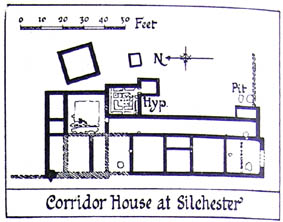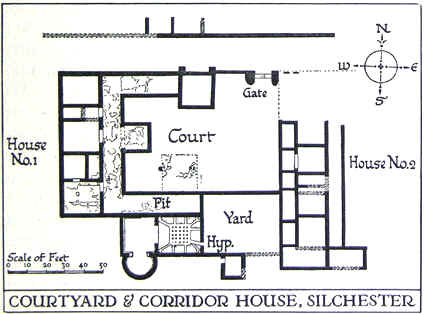Victoria
County History of Kent Vol. 3
1932
Romano-British
Kent - Introduction - Page 8
|
types is that sometimes called the Corridor type
(fig. 3). This type is used alike for small and for fairly large
houses, and is found as far away on the Continent as the Saalburg on
the Taunus, the extreme limit of the Romano-German frontier. It is
distinguished by a straight row or range of rooms with a corridor or
verandah running along them. Generally, some larger room projects at
one end; sometimes rooms project at both ends, forming wings, and
the resulting plans have some resemblance to those of many modern |

Fig. 3 Corridor House
|
|
cricket pavilions. More elaborate, but hardly
less common in the country districts, is the so-called Courtyard
type (fig. 4), which also occurs freely in northern Gaul, and
often reaches a very great size. In this essentially rural type,
three ranges of rooms fronted by corridors stand round three sides
of a large rectangular unroofed courtyard, which is entered by a
gateway in the middle of the fourth side. Other Courtyard houses,
built compactly round three or four sides of a small rectangular
yard or garden, represent in reality a somewhat different
tradition. They are an urban type, and are derived from the
‘peristyle’ town-houses of Italy and the Mediterranean
provinces.2 There are also simpler types of
building, of which two possess consistency enough to be
classified. In one of these we find a small oblong structure with
dwelling-rooms at one end, and barns or sheds at the other. In the
other, which we may call our fourth type, the living-rooms stand
at the two ends of a similar rectangle, with a small yard between
them (fig. 24, p. 107).
Not infrequently in the country two or three of these
types are used together to make up the equivalent of one large
house. At Brading, for instance (fig. 5), three detached
structures stand round a large yard. In the centre is a
luxuriously fitted corridor house (rooms i—xii), |
|

Fig 4 Courtyard House
|
obviously meant for the master and his family.
On the left is a ruder structure, perhaps of the fourth type,
intended in part for residence, and perhaps occupied by servants
(rooms xiv—xxx). On the right, a third block (rooms xxxii-xxxv)
may have contained barns or stables, and a structure beyond this (xxxvi)
may be a detached bath - house |
|
2
Compare Schwalb, Römische Villa bei Pola, plate 3;
Fondation Piot, iii, 177-226 ; Gsell, Revue
Africaine. xxxviii, 230, and Monuments de l’Algerie, ii,
18, 19; Déche1ette, Bibracte, p. 40. For an
important fresh survey of Romano-British house-plans, see R. G.
Collingwood, The Archaeology of Roman Britain (1930), p.
113. |
Previous
Page
Page 8 Next Page
Back
to Introduction
Contents
Page
This website is constructed
by enthusiastic amateurs. Any errors noticed by other researchers will be gratefully received so
that we can amend our pages to give as accurate a record as
possible. Please send details to localhistory@tedconnell.org.uk
|